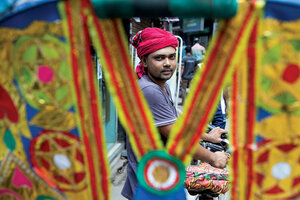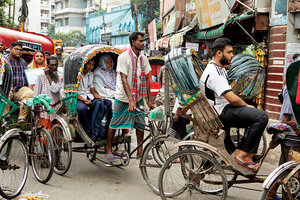Bangladesh’s cycle rickshaws bloom with bespoke designs. But for how much longer?

Cycle rickshaw driver Mohammad Rubel Hosen looks through the artwork on the back of his bike, in Old Dhaka, Bangladesh, in 2023. Most rickshaws are beautifully decorated.
Melanie Stetson Freeman/Staff
Dhaka, Bangladesh
If any scene captures the feeling of a visit to the Bangladeshi capital, Dhaka, it’s the thousands of cycle rickshaws rolling down the city’s thoroughfares. Decorated with pictures of bright flowers, birds, historic scenes, and movie stars, rickshaws don’t just get Bangladeshis from point A to point B. They also are part of the country’s urban folk art, and they define the mood of this dizzying and chaotic city.
But the art form is in danger of fading away. Panels that were once painted by hand to adorn the backs and sides of the three-wheeled human-powered vehicles are now printed by machine. Rickshaw drivers wanting to personalize their bikes are turning to digital art, which is cheaper and faster than commissioning an artist to create the pictures. That’s why UNESCO, in December, designated rickshaws – which are increasingly being replaced by motorized versions – and their decorative paintings as part of the Intangible Cultural Heritage of Humanity.
Syed Ahmed Hossain has been a rickshaw artist since 1969. His work has become so well known that he has presented it in exhibitions from Britain to Japan. He says he has even hosted ambassadors at his home, off a side alley in the heart of Dhaka. But he finds little market for rickshaw decorating today.
Why We Wrote This
Hand-painted cycle rickshaws have long characterized the dizzying Bangladeshi city of Dhaka. Now this urban folk art form is giving way to digitization.
Instead, he paints tin panels – as he is in the photo at bottom right – that he sells as artwork. This writer and photographer both purchased small panels – the perfect memento of any trip to Bangladesh.

